Assessment Guide: CHCDIS009 - Facilitate Ongoing Skills Development
VerifiedAdded on 2023/06/10
|24
|7664
|357
Homework Assignment
AI Summary
This student assessment guide for CHCDIS009 outlines the requirements for demonstrating competency in facilitating ongoing skills development using a person-centred approach. It includes two assessments: a workplace observation checklist assessing practical skills and a written question assessment covering theoretical knowledge. The guide details the unit and lecturer information, assessment tasks, and necessary declarations. The written assessment requires students to classify scenarios according to different theories (Social Model of Disability, Social Role Valorisation, Strengths-based, Active Support, and Self-determination), define person-centred practice, list services and educational opportunities for individuals with additional needs in the Northern Territory, identify the steps in skills development assessment, explain incidental learning, and describe strategies for fading prompts during instruction. The document emphasizes reasonable adjustments and ethical considerations in assessment.
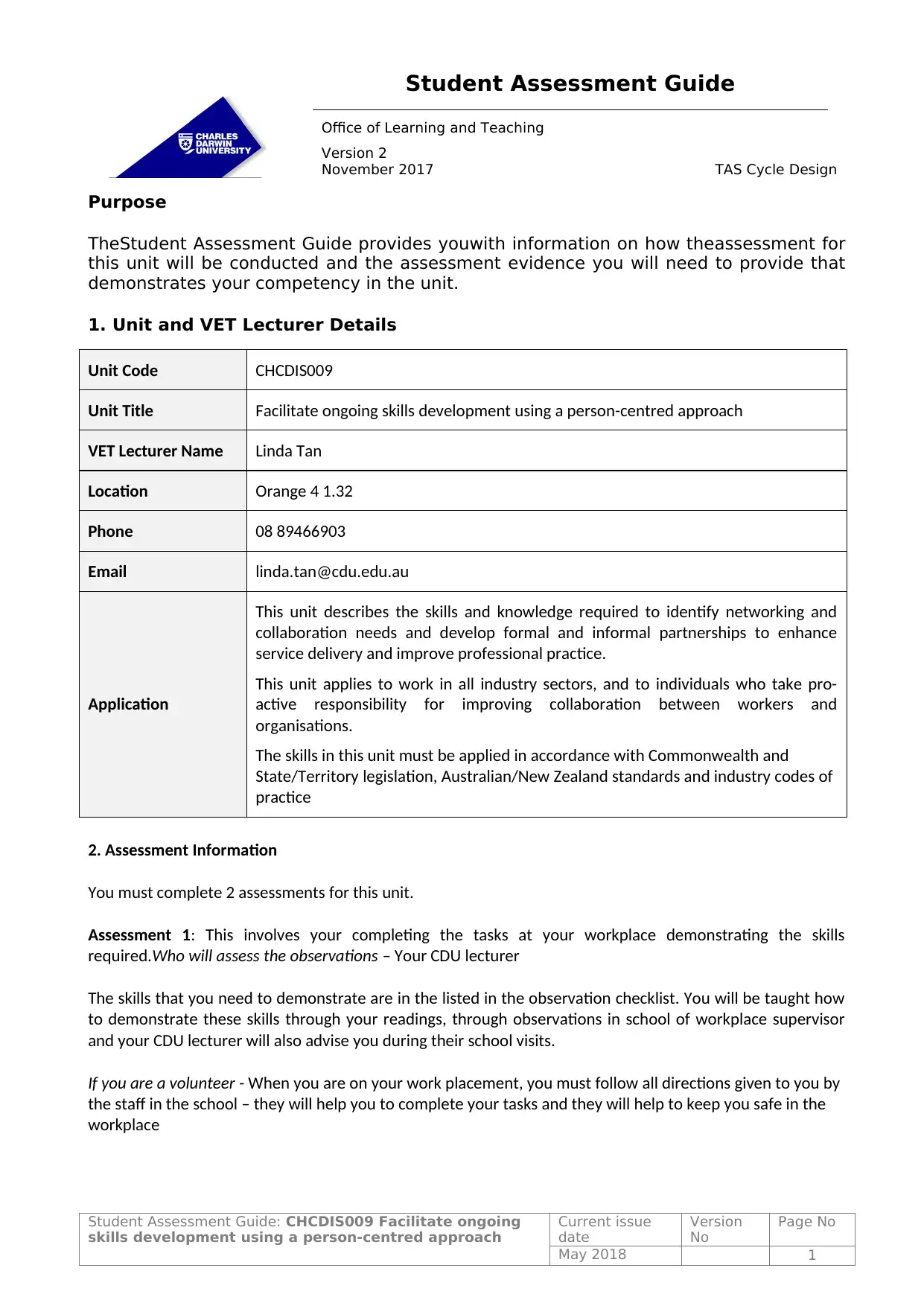
Student Assessment Guide
Office of Learning and Teaching
Version 2
November 2017 TAS Cycle Design
Purpose
TheStudent Assessment Guide provides youwith information on how theassessment for
this unit will be conducted and the assessment evidence you will need to provide that
demonstrates your competency in the unit.
1. Unit and VET Lecturer Details
Unit Code CHCDIS009
Unit Title Facilitate ongoing skills development using a person-centred approach
VET Lecturer Name Linda Tan
Location Orange 4 1.32
Phone 08 89466903
Email linda.tan@cdu.edu.au
Application
This unit describes the skills and knowledge required to identify networking and
collaboration needs and develop formal and informal partnerships to enhance
service delivery and improve professional practice.
This unit applies to work in all industry sectors, and to individuals who take pro-
active responsibility for improving collaboration between workers and
organisations.
The skills in this unit must be applied in accordance with Commonwealth and
State/Territory legislation, Australian/New Zealand standards and industry codes of
practice
2. Assessment Information
You must complete 2 assessments for this unit.
Assessment 1: This involves your completing the tasks at your workplace demonstrating the skills
required.Who will assess the observations – Your CDU lecturer
The skills that you need to demonstrate are in the listed in the observation checklist. You will be taught how
to demonstrate these skills through your readings, through observations in school of workplace supervisor
and your CDU lecturer will also advise you during their school visits.
If you are a volunteer - When you are on your work placement, you must follow all directions given to you by
the staff in the school – they will help you to complete your tasks and they will help to keep you safe in the
workplace
Student Assessment Guide: CHCDIS009 Facilitate ongoing
skills development using a person-centred approach
Current issue
date
Version
No
Page No
May 2018 1
Office of Learning and Teaching
Version 2
November 2017 TAS Cycle Design
Purpose
TheStudent Assessment Guide provides youwith information on how theassessment for
this unit will be conducted and the assessment evidence you will need to provide that
demonstrates your competency in the unit.
1. Unit and VET Lecturer Details
Unit Code CHCDIS009
Unit Title Facilitate ongoing skills development using a person-centred approach
VET Lecturer Name Linda Tan
Location Orange 4 1.32
Phone 08 89466903
Email linda.tan@cdu.edu.au
Application
This unit describes the skills and knowledge required to identify networking and
collaboration needs and develop formal and informal partnerships to enhance
service delivery and improve professional practice.
This unit applies to work in all industry sectors, and to individuals who take pro-
active responsibility for improving collaboration between workers and
organisations.
The skills in this unit must be applied in accordance with Commonwealth and
State/Territory legislation, Australian/New Zealand standards and industry codes of
practice
2. Assessment Information
You must complete 2 assessments for this unit.
Assessment 1: This involves your completing the tasks at your workplace demonstrating the skills
required.Who will assess the observations – Your CDU lecturer
The skills that you need to demonstrate are in the listed in the observation checklist. You will be taught how
to demonstrate these skills through your readings, through observations in school of workplace supervisor
and your CDU lecturer will also advise you during their school visits.
If you are a volunteer - When you are on your work placement, you must follow all directions given to you by
the staff in the school – they will help you to complete your tasks and they will help to keep you safe in the
workplace
Student Assessment Guide: CHCDIS009 Facilitate ongoing
skills development using a person-centred approach
Current issue
date
Version
No
Page No
May 2018 1
Paraphrase This Document
Need a fresh take? Get an instant paraphrase of this document with our AI Paraphraser
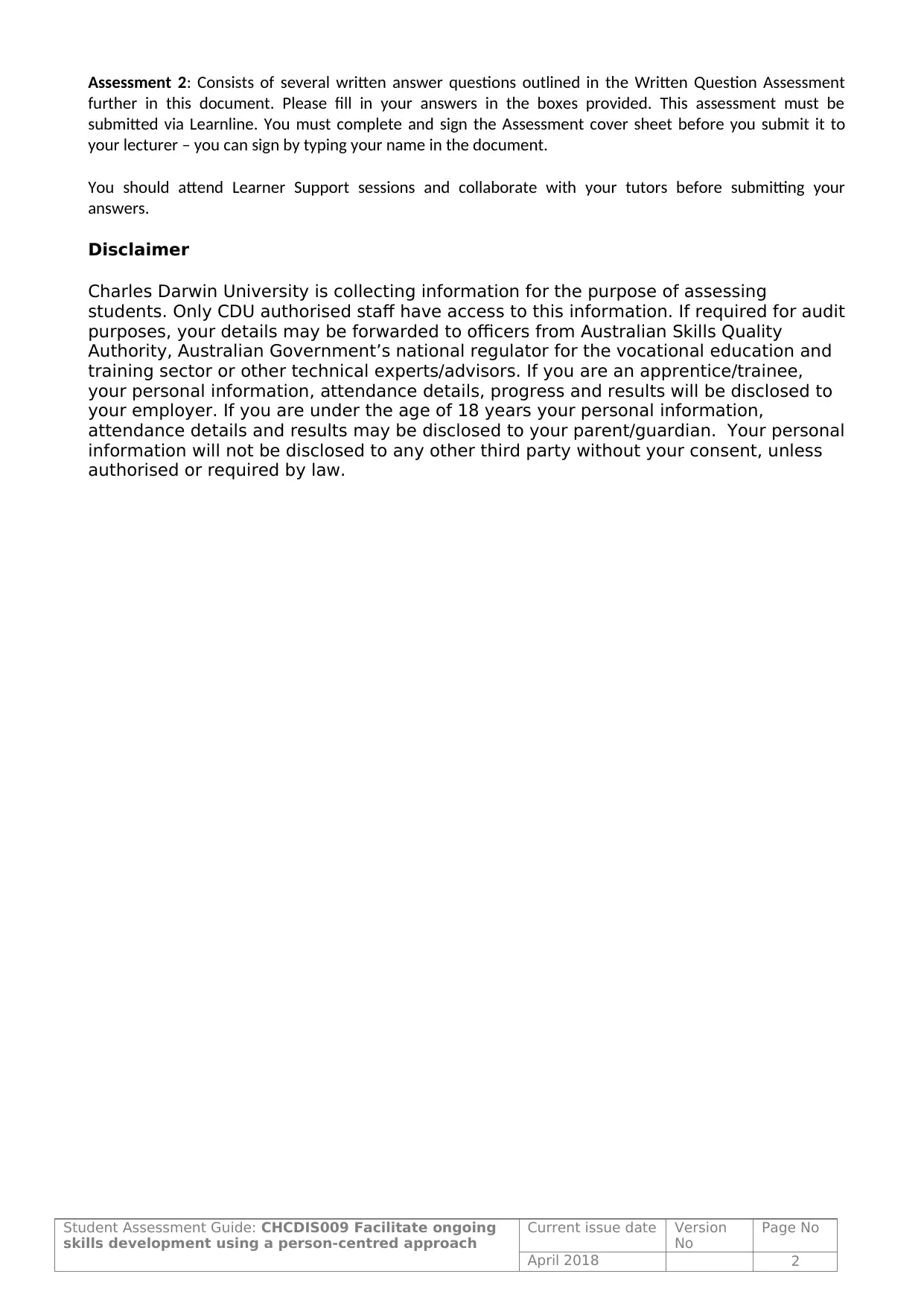
Assessment 2: Consists of several written answer questions outlined in the Written Question Assessment
further in this document. Please fill in your answers in the boxes provided. This assessment must be
submitted via Learnline. You must complete and sign the Assessment cover sheet before you submit it to
your lecturer – you can sign by typing your name in the document.
You should attend Learner Support sessions and collaborate with your tutors before submitting your
answers.
Disclaimer
Charles Darwin University is collecting information for the purpose of assessing
students. Only CDU authorised staff have access to this information. If required for audit
purposes, your details may be forwarded to officers from Australian Skills Quality
Authority, Australian Government’s national regulator for the vocational education and
training sector or other technical experts/advisors. If you are an apprentice/trainee,
your personal information, attendance details, progress and results will be disclosed to
your employer. If you are under the age of 18 years your personal information,
attendance details and results may be disclosed to your parent/guardian. Your personal
information will not be disclosed to any other third party without your consent, unless
authorised or required by law.
Student Assessment Guide: CHCDIS009 Facilitate ongoing
skills development using a person-centred approach
Current issue date Version
No
Page No
April 2018 2
further in this document. Please fill in your answers in the boxes provided. This assessment must be
submitted via Learnline. You must complete and sign the Assessment cover sheet before you submit it to
your lecturer – you can sign by typing your name in the document.
You should attend Learner Support sessions and collaborate with your tutors before submitting your
answers.
Disclaimer
Charles Darwin University is collecting information for the purpose of assessing
students. Only CDU authorised staff have access to this information. If required for audit
purposes, your details may be forwarded to officers from Australian Skills Quality
Authority, Australian Government’s national regulator for the vocational education and
training sector or other technical experts/advisors. If you are an apprentice/trainee,
your personal information, attendance details, progress and results will be disclosed to
your employer. If you are under the age of 18 years your personal information,
attendance details and results may be disclosed to your parent/guardian. Your personal
information will not be disclosed to any other third party without your consent, unless
authorised or required by law.
Student Assessment Guide: CHCDIS009 Facilitate ongoing
skills development using a person-centred approach
Current issue date Version
No
Page No
April 2018 2

Observation Checklist Assessment
Assessment Task Number: 1
Student Name: Student Number:
VET Lecturer/AssessorName:Linda Tan
Unit Code: CHCDIS009 Unit Title: : Facilitate ongoing skills development using a person-
centred approach
Due Date: Date Observed: Number of attempts
allowed: 3
Theobservation was conducted at:
Instructions to Student
To successfully demonstrate competency you must:
Satisfactorily complete all the Tasks listed in the Observation Checklist
Who will assess the observations- your lecturer will complete the checklist while they observe you face to
face during your work placement/s. Your nominated workplace supervisor may complete the Third Party
ReportSupplementary Evidenceto supplement the observations conducted by your lecturer. The skills that
you need to demonstrate during these tasks are listed in the checklist and you will be taught how to
demonstrate these skills through your readings, through observations of your workplace supervisor and by
your lecturer during their workplace visits.
If a volunteer - When you are on your work placement, you must follow all directions given to you by the
staff in the school – they will help you to complete your tasks and they will help to keep you safe in the
workplace.
Work Health and Safety: students are to follow the organisations workplace health and safety regulations
at all times and make themselves aware of what to do in the event of an emergency.
Clothing to be worn should be in line with the dress standards of the workplace, however in line with Work
Health safety standards all footwear is to include a ‘back strap’ – no ‘thongs’.
Your lecturer will observe you as you work and they will tick off all the skills (listed below) that they see
you demonstrating. If they do not see you demonstrating those skills, they will tell you and you will have
another 2 chances to demonstrate those skills.
Your lecturer might ask you some questions about what you are doing while you are in the workplace e.g.
they might ask you why you are doing something in a certain way or they might ask you what some of your
duties are etc.
Reasonable Adjustment
The assessor will record any adjustment made available to the student for this assessment–
e.g. time extensions, etc.
Initial questions to assess knowledge evidence before observation of competency.
Questions Comments Y N
Student Assessment Guide: CHCDIS009 Facilitate ongoing
skills development using a person-centred approach
Current issue date Version
No
Page No
April 2018 3
Assessment Task Number: 1
Student Name: Student Number:
VET Lecturer/AssessorName:Linda Tan
Unit Code: CHCDIS009 Unit Title: : Facilitate ongoing skills development using a person-
centred approach
Due Date: Date Observed: Number of attempts
allowed: 3
Theobservation was conducted at:
Instructions to Student
To successfully demonstrate competency you must:
Satisfactorily complete all the Tasks listed in the Observation Checklist
Who will assess the observations- your lecturer will complete the checklist while they observe you face to
face during your work placement/s. Your nominated workplace supervisor may complete the Third Party
ReportSupplementary Evidenceto supplement the observations conducted by your lecturer. The skills that
you need to demonstrate during these tasks are listed in the checklist and you will be taught how to
demonstrate these skills through your readings, through observations of your workplace supervisor and by
your lecturer during their workplace visits.
If a volunteer - When you are on your work placement, you must follow all directions given to you by the
staff in the school – they will help you to complete your tasks and they will help to keep you safe in the
workplace.
Work Health and Safety: students are to follow the organisations workplace health and safety regulations
at all times and make themselves aware of what to do in the event of an emergency.
Clothing to be worn should be in line with the dress standards of the workplace, however in line with Work
Health safety standards all footwear is to include a ‘back strap’ – no ‘thongs’.
Your lecturer will observe you as you work and they will tick off all the skills (listed below) that they see
you demonstrating. If they do not see you demonstrating those skills, they will tell you and you will have
another 2 chances to demonstrate those skills.
Your lecturer might ask you some questions about what you are doing while you are in the workplace e.g.
they might ask you why you are doing something in a certain way or they might ask you what some of your
duties are etc.
Reasonable Adjustment
The assessor will record any adjustment made available to the student for this assessment–
e.g. time extensions, etc.
Initial questions to assess knowledge evidence before observation of competency.
Questions Comments Y N
Student Assessment Guide: CHCDIS009 Facilitate ongoing
skills development using a person-centred approach
Current issue date Version
No
Page No
April 2018 3
⊘ This is a preview!⊘
Do you want full access?
Subscribe today to unlock all pages.

Trusted by 1+ million students worldwide
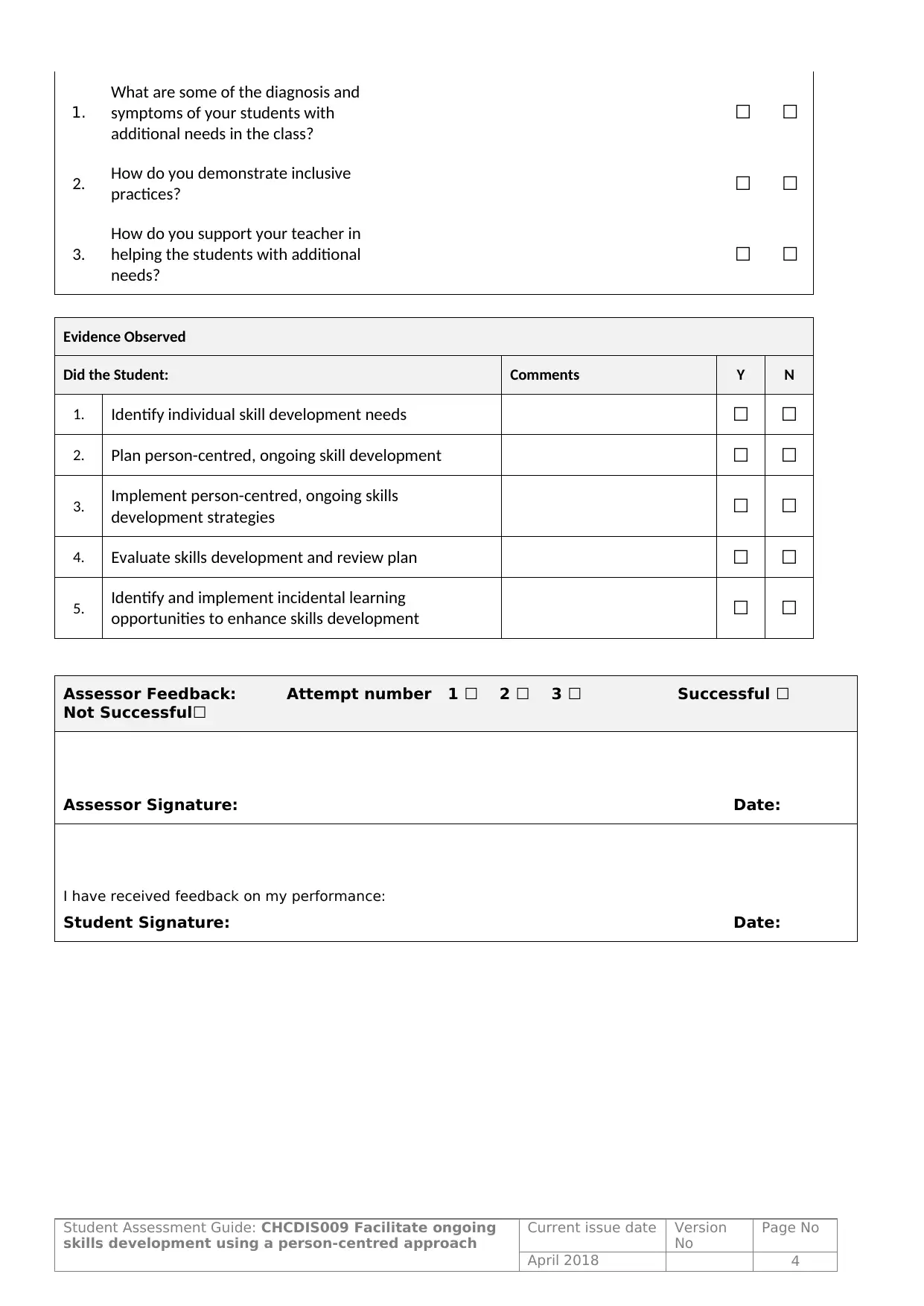
1.
What are some of the diagnosis and
symptoms of your students with
additional needs in the class?
☐ ☐
2. How do you demonstrate inclusive
practices? ☐ ☐
3.
How do you support your teacher in
helping the students with additional
needs?
☐ ☐
Evidence Observed
Did the Student: Comments Y N
1. Identify individual skill development needs ☐ ☐
2. Plan person-centred, ongoing skill development ☐ ☐
3. Implement person-centred, ongoing skills
development strategies ☐ ☐
4. Evaluate skills development and review plan ☐ ☐
5. Identify and implement incidental learning
opportunities to enhance skills development ☐ ☐
Assessor Feedback: Attempt number 1 ☐ 2 ☐ 3 ☐ Successful ☐
Not Successful☐
Assessor Signature: Date:
I have received feedback on my performance:
Student Signature: Date:
Student Assessment Guide: CHCDIS009 Facilitate ongoing
skills development using a person-centred approach
Current issue date Version
No
Page No
April 2018 4
What are some of the diagnosis and
symptoms of your students with
additional needs in the class?
☐ ☐
2. How do you demonstrate inclusive
practices? ☐ ☐
3.
How do you support your teacher in
helping the students with additional
needs?
☐ ☐
Evidence Observed
Did the Student: Comments Y N
1. Identify individual skill development needs ☐ ☐
2. Plan person-centred, ongoing skill development ☐ ☐
3. Implement person-centred, ongoing skills
development strategies ☐ ☐
4. Evaluate skills development and review plan ☐ ☐
5. Identify and implement incidental learning
opportunities to enhance skills development ☐ ☐
Assessor Feedback: Attempt number 1 ☐ 2 ☐ 3 ☐ Successful ☐
Not Successful☐
Assessor Signature: Date:
I have received feedback on my performance:
Student Signature: Date:
Student Assessment Guide: CHCDIS009 Facilitate ongoing
skills development using a person-centred approach
Current issue date Version
No
Page No
April 2018 4
Paraphrase This Document
Need a fresh take? Get an instant paraphrase of this document with our AI Paraphraser
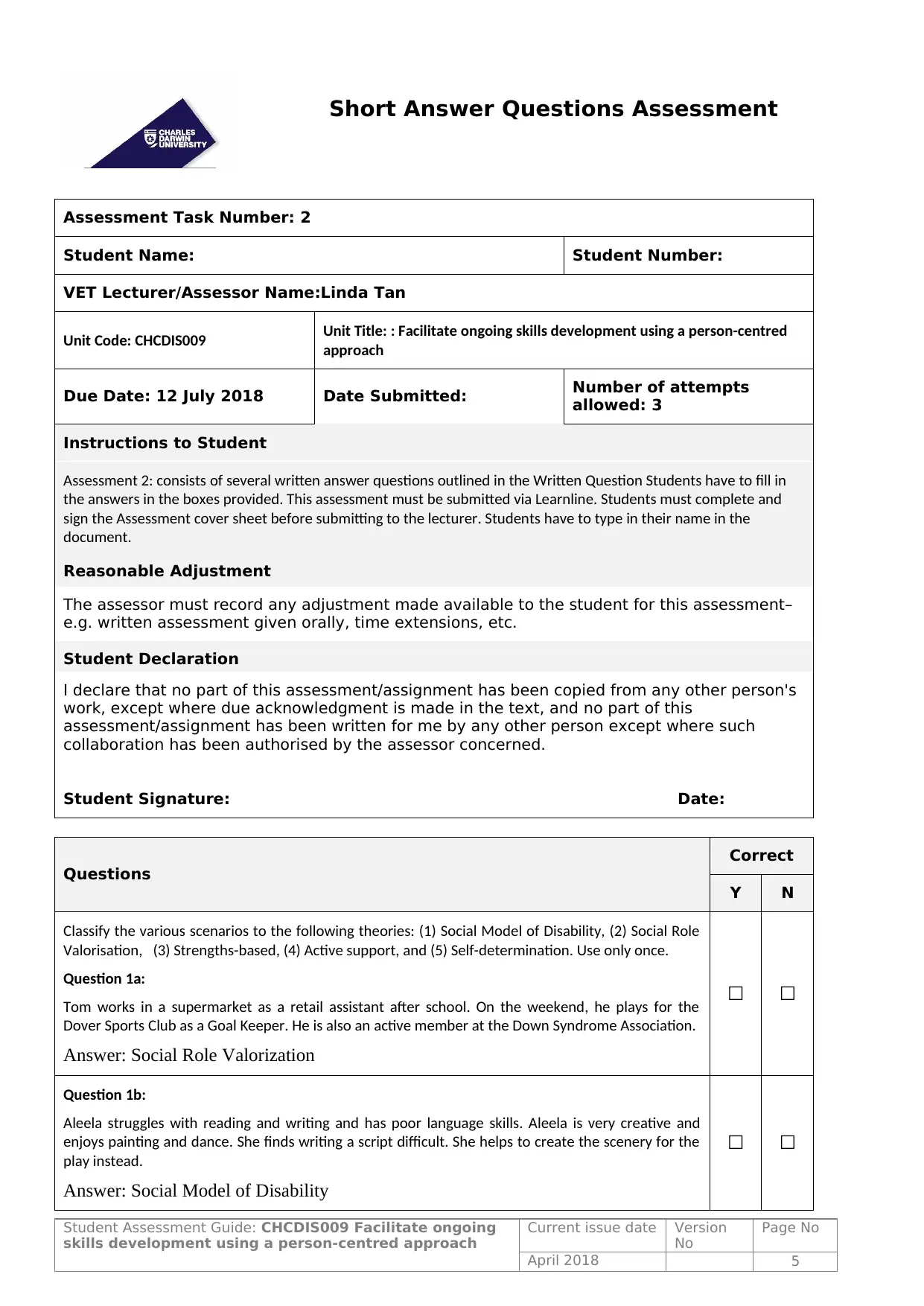
Short Answer Questions Assessment
Assessment Task Number: 2
Student Name: Student Number:
VET Lecturer/Assessor Name:Linda Tan
Unit Code: CHCDIS009 Unit Title: : Facilitate ongoing skills development using a person-centred
approach
Due Date: 12 July 2018 Date Submitted: Number of attempts
allowed: 3
Instructions to Student
Assessment 2: consists of several written answer questions outlined in the Written Question Students have to fill in
the answers in the boxes provided. This assessment must be submitted via Learnline. Students must complete and
sign the Assessment cover sheet before submitting to the lecturer. Students have to type in their name in the
document.
Reasonable Adjustment
The assessor must record any adjustment made available to the student for this assessment–
e.g. written assessment given orally, time extensions, etc.
Student Declaration
I declare that no part of this assessment/assignment has been copied from any other person's
work, except where due acknowledgment is made in the text, and no part of this
assessment/assignment has been written for me by any other person except where such
collaboration has been authorised by the assessor concerned.
Student Signature: Date:
Questions
Correct
Y N
Classify the various scenarios to the following theories: (1) Social Model of Disability, (2) Social Role
Valorisation, (3) Strengths-based, (4) Active support, and (5) Self-determination. Use only once.
Question 1a:
Tom works in a supermarket as a retail assistant after school. On the weekend, he plays for the
Dover Sports Club as a Goal Keeper. He is also an active member at the Down Syndrome Association.
Answer: Social Role Valorization
☐ ☐
Question 1b:
Aleela struggles with reading and writing and has poor language skills. Aleela is very creative and
enjoys painting and dance. She finds writing a script difficult. She helps to create the scenery for the
play instead.
Answer: Social Model of Disability
☐ ☐
Student Assessment Guide: CHCDIS009 Facilitate ongoing
skills development using a person-centred approach
Current issue date Version
No
Page No
April 2018 5
Assessment Task Number: 2
Student Name: Student Number:
VET Lecturer/Assessor Name:Linda Tan
Unit Code: CHCDIS009 Unit Title: : Facilitate ongoing skills development using a person-centred
approach
Due Date: 12 July 2018 Date Submitted: Number of attempts
allowed: 3
Instructions to Student
Assessment 2: consists of several written answer questions outlined in the Written Question Students have to fill in
the answers in the boxes provided. This assessment must be submitted via Learnline. Students must complete and
sign the Assessment cover sheet before submitting to the lecturer. Students have to type in their name in the
document.
Reasonable Adjustment
The assessor must record any adjustment made available to the student for this assessment–
e.g. written assessment given orally, time extensions, etc.
Student Declaration
I declare that no part of this assessment/assignment has been copied from any other person's
work, except where due acknowledgment is made in the text, and no part of this
assessment/assignment has been written for me by any other person except where such
collaboration has been authorised by the assessor concerned.
Student Signature: Date:
Questions
Correct
Y N
Classify the various scenarios to the following theories: (1) Social Model of Disability, (2) Social Role
Valorisation, (3) Strengths-based, (4) Active support, and (5) Self-determination. Use only once.
Question 1a:
Tom works in a supermarket as a retail assistant after school. On the weekend, he plays for the
Dover Sports Club as a Goal Keeper. He is also an active member at the Down Syndrome Association.
Answer: Social Role Valorization
☐ ☐
Question 1b:
Aleela struggles with reading and writing and has poor language skills. Aleela is very creative and
enjoys painting and dance. She finds writing a script difficult. She helps to create the scenery for the
play instead.
Answer: Social Model of Disability
☐ ☐
Student Assessment Guide: CHCDIS009 Facilitate ongoing
skills development using a person-centred approach
Current issue date Version
No
Page No
April 2018 5
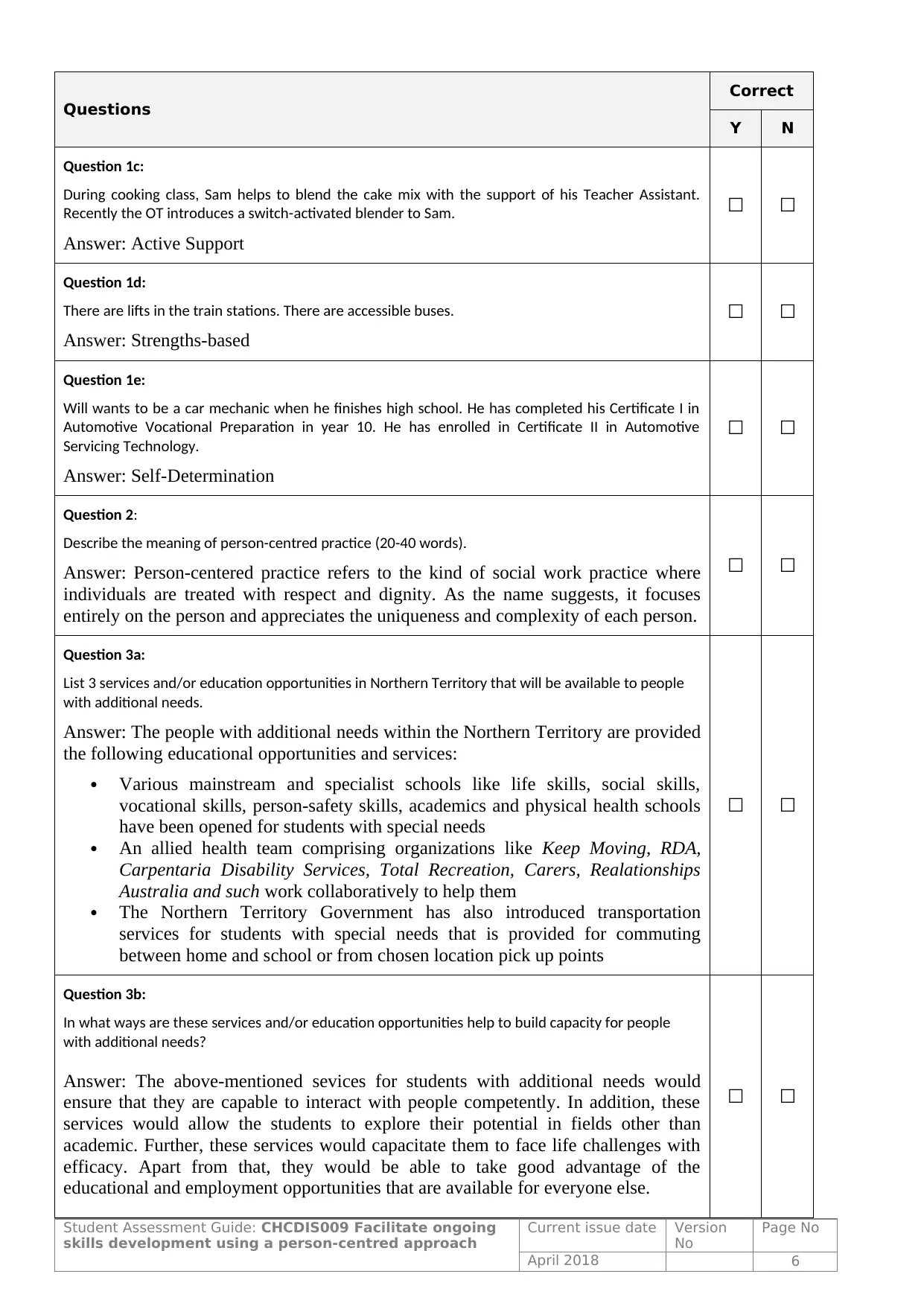
Questions
Correct
Y N
Question 1c:
During cooking class, Sam helps to blend the cake mix with the support of his Teacher Assistant.
Recently the OT introduces a switch-activated blender to Sam.
Answer: Active Support
☐ ☐
Question 1d:
There are lifts in the train stations. There are accessible buses.
Answer: Strengths-based
☐ ☐
Question 1e:
Will wants to be a car mechanic when he finishes high school. He has completed his Certificate I in
Automotive Vocational Preparation in year 10. He has enrolled in Certificate II in Automotive
Servicing Technology.
Answer: Self-Determination
☐ ☐
Question 2:
Describe the meaning of person-centred practice (20-40 words).
Answer: Person-centered practice refers to the kind of social work practice where
individuals are treated with respect and dignity. As the name suggests, it focuses
entirely on the person and appreciates the uniqueness and complexity of each person.
☐ ☐
Question 3a:
List 3 services and/or education opportunities in Northern Territory that will be available to people
with additional needs.
Answer: The people with additional needs within the Northern Territory are provided
the following educational opportunities and services:
Various mainstream and specialist schools like life skills, social skills,
vocational skills, person-safety skills, academics and physical health schools
have been opened for students with special needs
An allied health team comprising organizations like Keep Moving, RDA,
Carpentaria Disability Services, Total Recreation, Carers, Realationships
Australia and such work collaboratively to help them
The Northern Territory Government has also introduced transportation
services for students with special needs that is provided for commuting
between home and school or from chosen location pick up points
☐ ☐
Question 3b:
In what ways are these services and/or education opportunities help to build capacity for people
with additional needs?
Answer: The above-mentioned sevices for students with additional needs would
ensure that they are capable to interact with people competently. In addition, these
services would allow the students to explore their potential in fields other than
academic. Further, these services would capacitate them to face life challenges with
efficacy. Apart from that, they would be able to take good advantage of the
educational and employment opportunities that are available for everyone else.
☐ ☐
Student Assessment Guide: CHCDIS009 Facilitate ongoing
skills development using a person-centred approach
Current issue date Version
No
Page No
April 2018 6
Correct
Y N
Question 1c:
During cooking class, Sam helps to blend the cake mix with the support of his Teacher Assistant.
Recently the OT introduces a switch-activated blender to Sam.
Answer: Active Support
☐ ☐
Question 1d:
There are lifts in the train stations. There are accessible buses.
Answer: Strengths-based
☐ ☐
Question 1e:
Will wants to be a car mechanic when he finishes high school. He has completed his Certificate I in
Automotive Vocational Preparation in year 10. He has enrolled in Certificate II in Automotive
Servicing Technology.
Answer: Self-Determination
☐ ☐
Question 2:
Describe the meaning of person-centred practice (20-40 words).
Answer: Person-centered practice refers to the kind of social work practice where
individuals are treated with respect and dignity. As the name suggests, it focuses
entirely on the person and appreciates the uniqueness and complexity of each person.
☐ ☐
Question 3a:
List 3 services and/or education opportunities in Northern Territory that will be available to people
with additional needs.
Answer: The people with additional needs within the Northern Territory are provided
the following educational opportunities and services:
Various mainstream and specialist schools like life skills, social skills,
vocational skills, person-safety skills, academics and physical health schools
have been opened for students with special needs
An allied health team comprising organizations like Keep Moving, RDA,
Carpentaria Disability Services, Total Recreation, Carers, Realationships
Australia and such work collaboratively to help them
The Northern Territory Government has also introduced transportation
services for students with special needs that is provided for commuting
between home and school or from chosen location pick up points
☐ ☐
Question 3b:
In what ways are these services and/or education opportunities help to build capacity for people
with additional needs?
Answer: The above-mentioned sevices for students with additional needs would
ensure that they are capable to interact with people competently. In addition, these
services would allow the students to explore their potential in fields other than
academic. Further, these services would capacitate them to face life challenges with
efficacy. Apart from that, they would be able to take good advantage of the
educational and employment opportunities that are available for everyone else.
☐ ☐
Student Assessment Guide: CHCDIS009 Facilitate ongoing
skills development using a person-centred approach
Current issue date Version
No
Page No
April 2018 6
⊘ This is a preview!⊘
Do you want full access?
Subscribe today to unlock all pages.

Trusted by 1+ million students worldwide
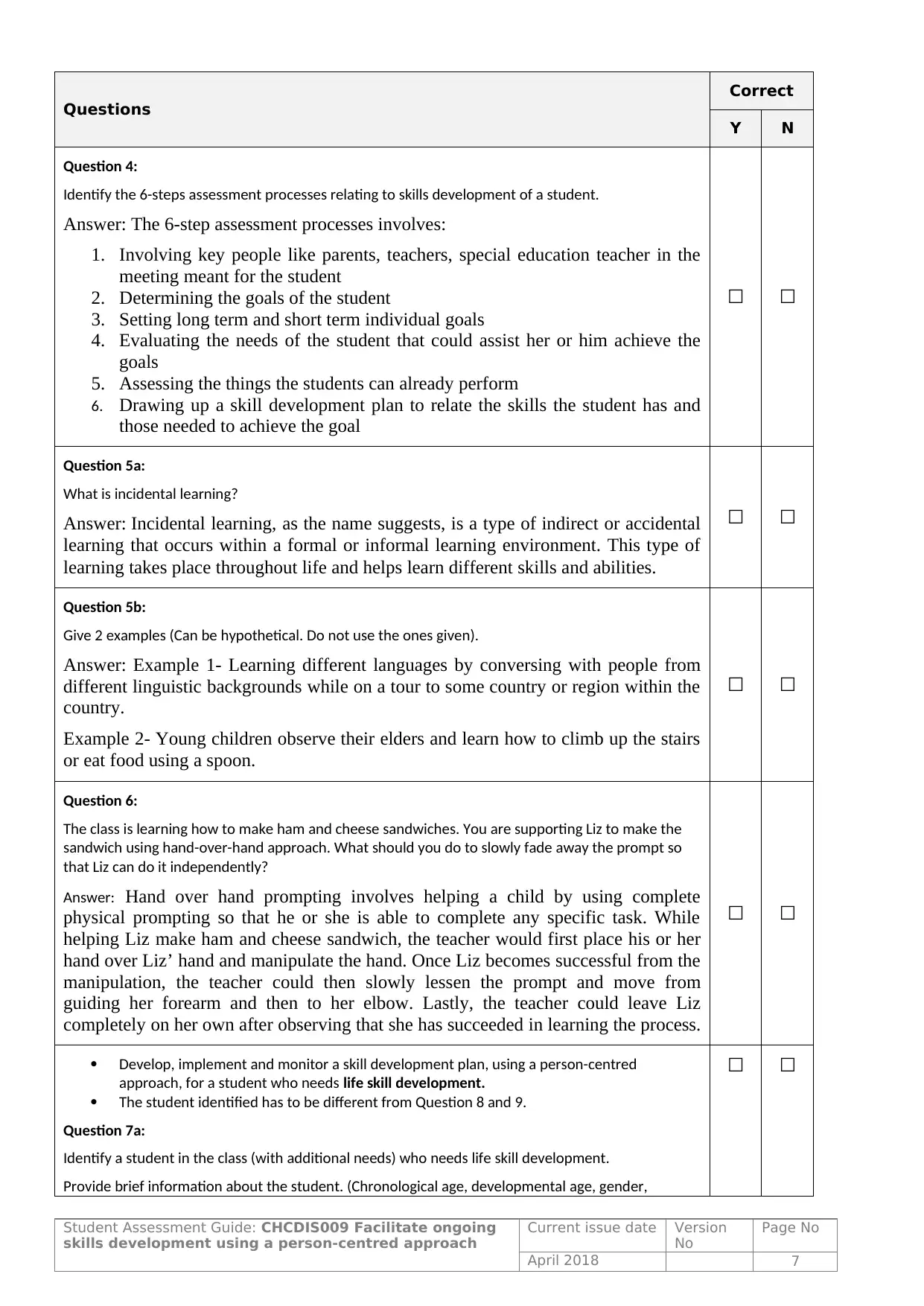
Questions
Correct
Y N
Question 4:
Identify the 6-steps assessment processes relating to skills development of a student.
Answer: The 6-step assessment processes involves:
1. Involving key people like parents, teachers, special education teacher in the
meeting meant for the student
2. Determining the goals of the student
3. Setting long term and short term individual goals
4. Evaluating the needs of the student that could assist her or him achieve the
goals
5. Assessing the things the students can already perform
6. Drawing up a skill development plan to relate the skills the student has and
those needed to achieve the goal
☐ ☐
Question 5a:
What is incidental learning?
Answer: Incidental learning, as the name suggests, is a type of indirect or accidental
learning that occurs within a formal or informal learning environment. This type of
learning takes place throughout life and helps learn different skills and abilities.
☐ ☐
Question 5b:
Give 2 examples (Can be hypothetical. Do not use the ones given).
Answer: Example 1- Learning different languages by conversing with people from
different linguistic backgrounds while on a tour to some country or region within the
country.
Example 2- Young children observe their elders and learn how to climb up the stairs
or eat food using a spoon.
☐ ☐
Question 6:
The class is learning how to make ham and cheese sandwiches. You are supporting Liz to make the
sandwich using hand-over-hand approach. What should you do to slowly fade away the prompt so
that Liz can do it independently?
Answer: Hand over hand prompting involves helping a child by using complete
physical prompting so that he or she is able to complete any specific task. While
helping Liz make ham and cheese sandwich, the teacher would first place his or her
hand over Liz’ hand and manipulate the hand. Once Liz becomes successful from the
manipulation, the teacher could then slowly lessen the prompt and move from
guiding her forearm and then to her elbow. Lastly, the teacher could leave Liz
completely on her own after observing that she has succeeded in learning the process.
☐ ☐
Develop, implement and monitor a skill development plan, using a person-centred
approach, for a student who needs life skill development.
The student identified has to be different from Question 8 and 9.
Question 7a:
Identify a student in the class (with additional needs) who needs life skill development.
Provide brief information about the student. (Chronological age, developmental age, gender,
☐ ☐
Student Assessment Guide: CHCDIS009 Facilitate ongoing
skills development using a person-centred approach
Current issue date Version
No
Page No
April 2018 7
Correct
Y N
Question 4:
Identify the 6-steps assessment processes relating to skills development of a student.
Answer: The 6-step assessment processes involves:
1. Involving key people like parents, teachers, special education teacher in the
meeting meant for the student
2. Determining the goals of the student
3. Setting long term and short term individual goals
4. Evaluating the needs of the student that could assist her or him achieve the
goals
5. Assessing the things the students can already perform
6. Drawing up a skill development plan to relate the skills the student has and
those needed to achieve the goal
☐ ☐
Question 5a:
What is incidental learning?
Answer: Incidental learning, as the name suggests, is a type of indirect or accidental
learning that occurs within a formal or informal learning environment. This type of
learning takes place throughout life and helps learn different skills and abilities.
☐ ☐
Question 5b:
Give 2 examples (Can be hypothetical. Do not use the ones given).
Answer: Example 1- Learning different languages by conversing with people from
different linguistic backgrounds while on a tour to some country or region within the
country.
Example 2- Young children observe their elders and learn how to climb up the stairs
or eat food using a spoon.
☐ ☐
Question 6:
The class is learning how to make ham and cheese sandwiches. You are supporting Liz to make the
sandwich using hand-over-hand approach. What should you do to slowly fade away the prompt so
that Liz can do it independently?
Answer: Hand over hand prompting involves helping a child by using complete
physical prompting so that he or she is able to complete any specific task. While
helping Liz make ham and cheese sandwich, the teacher would first place his or her
hand over Liz’ hand and manipulate the hand. Once Liz becomes successful from the
manipulation, the teacher could then slowly lessen the prompt and move from
guiding her forearm and then to her elbow. Lastly, the teacher could leave Liz
completely on her own after observing that she has succeeded in learning the process.
☐ ☐
Develop, implement and monitor a skill development plan, using a person-centred
approach, for a student who needs life skill development.
The student identified has to be different from Question 8 and 9.
Question 7a:
Identify a student in the class (with additional needs) who needs life skill development.
Provide brief information about the student. (Chronological age, developmental age, gender,
☐ ☐
Student Assessment Guide: CHCDIS009 Facilitate ongoing
skills development using a person-centred approach
Current issue date Version
No
Page No
April 2018 7
Paraphrase This Document
Need a fresh take? Get an instant paraphrase of this document with our AI Paraphraser
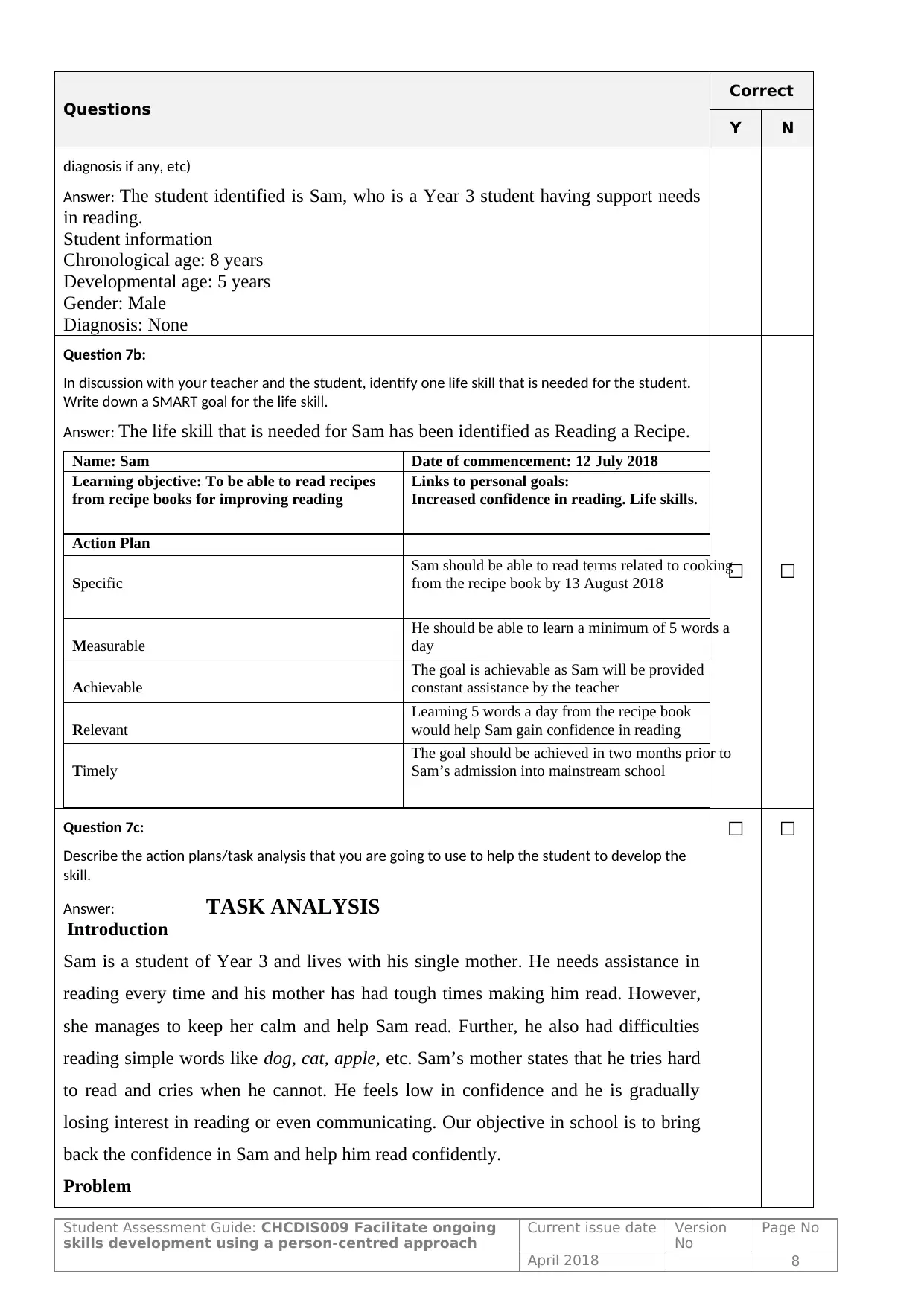
Questions
Correct
Y N
diagnosis if any, etc)
Answer: The student identified is Sam, who is a Year 3 student having support needs
in reading.
Student information
Chronological age: 8 years
Developmental age: 5 years
Gender: Male
Diagnosis: None
Question 7b:
In discussion with your teacher and the student, identify one life skill that is needed for the student.
Write down a SMART goal for the life skill.
Answer: The life skill that is needed for Sam has been identified as Reading a Recipe.
Name: Sam Date of commencement: 12 July 2018
Learning objective: To be able to read recipes
from recipe books for improving reading
Links to personal goals:
Increased confidence in reading. Life skills.
Action Plan
Specific
Sam should be able to read terms related to cooking
from the recipe book by 13 August 2018
Measurable
He should be able to learn a minimum of 5 words a
day
Achievable
The goal is achievable as Sam will be provided
constant assistance by the teacher
Relevant
Learning 5 words a day from the recipe book
would help Sam gain confidence in reading
Timely
The goal should be achieved in two months prior to
Sam’s admission into mainstream school
☐ ☐
Question 7c:
Describe the action plans/task analysis that you are going to use to help the student to develop the
skill.
Answer: TASK ANALYSIS
Introduction
Sam is a student of Year 3 and lives with his single mother. He needs assistance in
reading every time and his mother has had tough times making him read. However,
she manages to keep her calm and help Sam read. Further, he also had difficulties
reading simple words like dog, cat, apple, etc. Sam’s mother states that he tries hard
to read and cries when he cannot. He feels low in confidence and he is gradually
losing interest in reading or even communicating. Our objective in school is to bring
back the confidence in Sam and help him read confidently.
Problem
☐ ☐
Student Assessment Guide: CHCDIS009 Facilitate ongoing
skills development using a person-centred approach
Current issue date Version
No
Page No
April 2018 8
Correct
Y N
diagnosis if any, etc)
Answer: The student identified is Sam, who is a Year 3 student having support needs
in reading.
Student information
Chronological age: 8 years
Developmental age: 5 years
Gender: Male
Diagnosis: None
Question 7b:
In discussion with your teacher and the student, identify one life skill that is needed for the student.
Write down a SMART goal for the life skill.
Answer: The life skill that is needed for Sam has been identified as Reading a Recipe.
Name: Sam Date of commencement: 12 July 2018
Learning objective: To be able to read recipes
from recipe books for improving reading
Links to personal goals:
Increased confidence in reading. Life skills.
Action Plan
Specific
Sam should be able to read terms related to cooking
from the recipe book by 13 August 2018
Measurable
He should be able to learn a minimum of 5 words a
day
Achievable
The goal is achievable as Sam will be provided
constant assistance by the teacher
Relevant
Learning 5 words a day from the recipe book
would help Sam gain confidence in reading
Timely
The goal should be achieved in two months prior to
Sam’s admission into mainstream school
☐ ☐
Question 7c:
Describe the action plans/task analysis that you are going to use to help the student to develop the
skill.
Answer: TASK ANALYSIS
Introduction
Sam is a student of Year 3 and lives with his single mother. He needs assistance in
reading every time and his mother has had tough times making him read. However,
she manages to keep her calm and help Sam read. Further, he also had difficulties
reading simple words like dog, cat, apple, etc. Sam’s mother states that he tries hard
to read and cries when he cannot. He feels low in confidence and he is gradually
losing interest in reading or even communicating. Our objective in school is to bring
back the confidence in Sam and help him read confidently.
Problem
☐ ☐
Student Assessment Guide: CHCDIS009 Facilitate ongoing
skills development using a person-centred approach
Current issue date Version
No
Page No
April 2018 8

Questions
Correct
Y N
We help children learn different recipes and prepare those by themselves. However,
it becomes extremely difficult for us to read aloud the recipe book and then explain it
to each student. The process also consumes time and energy. Therefore, it becomes a
lot easier for both students and teachers if the students are able to read and
comprehend the recipe book. The ‘find the next item’ is an interesting and simple
activity to allow students read from the recipe book without adult help.
Goal
The goal I have decided to achieve for Sam is to have him read the recipe book
successfully without any supervision. I am expecting Sam to read at least five items a
day and understand what the words mean. The goal shall be achieved with one
successful completion of the activity. Sam’s achievement can then be measured by
observing the way he gazes at the recipe book and reads the items.
Implementation
I will involve Sam in preparing a dish, something that he loves to eat. Then, I will
ask him to find the next item needed to prepare the dish from the recipe book and
recite it to me.
The ‘Find the next item’ activity
Find a recipe book with visuals
Bring it to the class
Ask the students about their favorite dish
Assist the teacher in preparing the dish
Read out the items of the recipe one by one
Find the next item and read it aloud to the teacher
Outcome
Sam was excited to read the items from the recipe book and help me prepare the dish.
Initially he had problems reading the items. I had to read it aloud for Sam to follow
me. I also had to point out the visuals that referred to the item for Sam to understand.
Once he was able to grasp the meaning of the items, it was easier for him to read.
The next day I observed that Sam was already prepared to indulge in the activity and
excited to read out the items. It was not easy for him as he initially showed me the
pictures of the items from the recipe book. Gradually, he was confident enough to
read.
Student Assessment Guide: CHCDIS009 Facilitate ongoing
skills development using a person-centred approach
Current issue date Version
No
Page No
April 2018 9
Correct
Y N
We help children learn different recipes and prepare those by themselves. However,
it becomes extremely difficult for us to read aloud the recipe book and then explain it
to each student. The process also consumes time and energy. Therefore, it becomes a
lot easier for both students and teachers if the students are able to read and
comprehend the recipe book. The ‘find the next item’ is an interesting and simple
activity to allow students read from the recipe book without adult help.
Goal
The goal I have decided to achieve for Sam is to have him read the recipe book
successfully without any supervision. I am expecting Sam to read at least five items a
day and understand what the words mean. The goal shall be achieved with one
successful completion of the activity. Sam’s achievement can then be measured by
observing the way he gazes at the recipe book and reads the items.
Implementation
I will involve Sam in preparing a dish, something that he loves to eat. Then, I will
ask him to find the next item needed to prepare the dish from the recipe book and
recite it to me.
The ‘Find the next item’ activity
Find a recipe book with visuals
Bring it to the class
Ask the students about their favorite dish
Assist the teacher in preparing the dish
Read out the items of the recipe one by one
Find the next item and read it aloud to the teacher
Outcome
Sam was excited to read the items from the recipe book and help me prepare the dish.
Initially he had problems reading the items. I had to read it aloud for Sam to follow
me. I also had to point out the visuals that referred to the item for Sam to understand.
Once he was able to grasp the meaning of the items, it was easier for him to read.
The next day I observed that Sam was already prepared to indulge in the activity and
excited to read out the items. It was not easy for him as he initially showed me the
pictures of the items from the recipe book. Gradually, he was confident enough to
read.
Student Assessment Guide: CHCDIS009 Facilitate ongoing
skills development using a person-centred approach
Current issue date Version
No
Page No
April 2018 9
⊘ This is a preview!⊘
Do you want full access?
Subscribe today to unlock all pages.

Trusted by 1+ million students worldwide
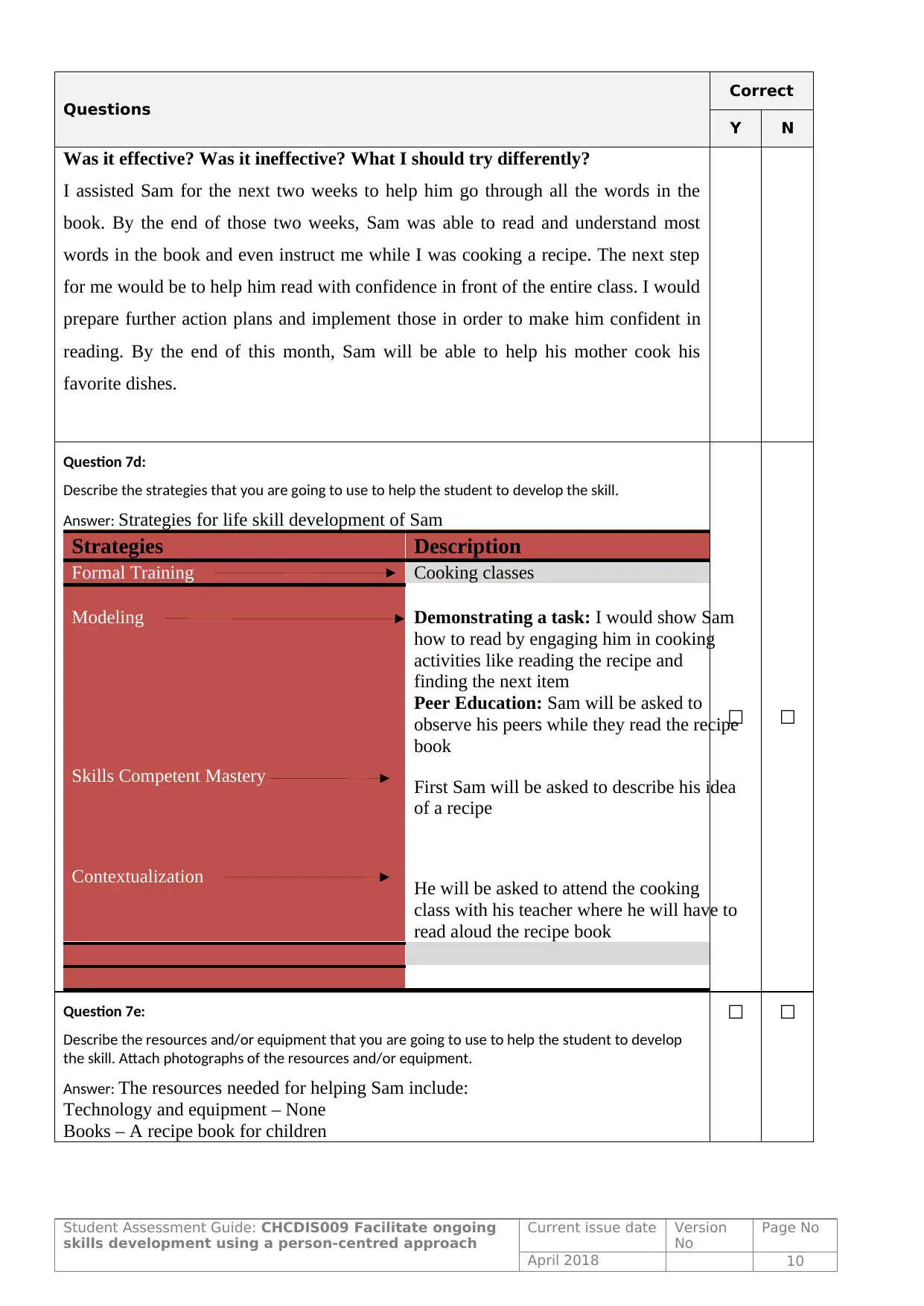
Questions
Correct
Y N
Was it effective? Was it ineffective? What I should try differently?
I assisted Sam for the next two weeks to help him go through all the words in the
book. By the end of those two weeks, Sam was able to read and understand most
words in the book and even instruct me while I was cooking a recipe. The next step
for me would be to help him read with confidence in front of the entire class. I would
prepare further action plans and implement those in order to make him confident in
reading. By the end of this month, Sam will be able to help his mother cook his
favorite dishes.
Question 7d:
Describe the strategies that you are going to use to help the student to develop the skill.
Answer: Strategies for life skill development of Sam
Strategies Description
Formal Training Cooking classes
Modeling
Skills Competent Mastery
Contextualization
Demonstrating a task: I would show Sam
how to read by engaging him in cooking
activities like reading the recipe and
finding the next item
Peer Education: Sam will be asked to
observe his peers while they read the recipe
book
First Sam will be asked to describe his idea
of a recipe
He will be asked to attend the cooking
class with his teacher where he will have to
read aloud the recipe book
☐ ☐
Question 7e:
Describe the resources and/or equipment that you are going to use to help the student to develop
the skill. Attach photographs of the resources and/or equipment.
Answer: The resources needed for helping Sam include:
Technology and equipment – None
Books – A recipe book for children
☐ ☐
Student Assessment Guide: CHCDIS009 Facilitate ongoing
skills development using a person-centred approach
Current issue date Version
No
Page No
April 2018 10
Correct
Y N
Was it effective? Was it ineffective? What I should try differently?
I assisted Sam for the next two weeks to help him go through all the words in the
book. By the end of those two weeks, Sam was able to read and understand most
words in the book and even instruct me while I was cooking a recipe. The next step
for me would be to help him read with confidence in front of the entire class. I would
prepare further action plans and implement those in order to make him confident in
reading. By the end of this month, Sam will be able to help his mother cook his
favorite dishes.
Question 7d:
Describe the strategies that you are going to use to help the student to develop the skill.
Answer: Strategies for life skill development of Sam
Strategies Description
Formal Training Cooking classes
Modeling
Skills Competent Mastery
Contextualization
Demonstrating a task: I would show Sam
how to read by engaging him in cooking
activities like reading the recipe and
finding the next item
Peer Education: Sam will be asked to
observe his peers while they read the recipe
book
First Sam will be asked to describe his idea
of a recipe
He will be asked to attend the cooking
class with his teacher where he will have to
read aloud the recipe book
☐ ☐
Question 7e:
Describe the resources and/or equipment that you are going to use to help the student to develop
the skill. Attach photographs of the resources and/or equipment.
Answer: The resources needed for helping Sam include:
Technology and equipment – None
Books – A recipe book for children
☐ ☐
Student Assessment Guide: CHCDIS009 Facilitate ongoing
skills development using a person-centred approach
Current issue date Version
No
Page No
April 2018 10
Paraphrase This Document
Need a fresh take? Get an instant paraphrase of this document with our AI Paraphraser
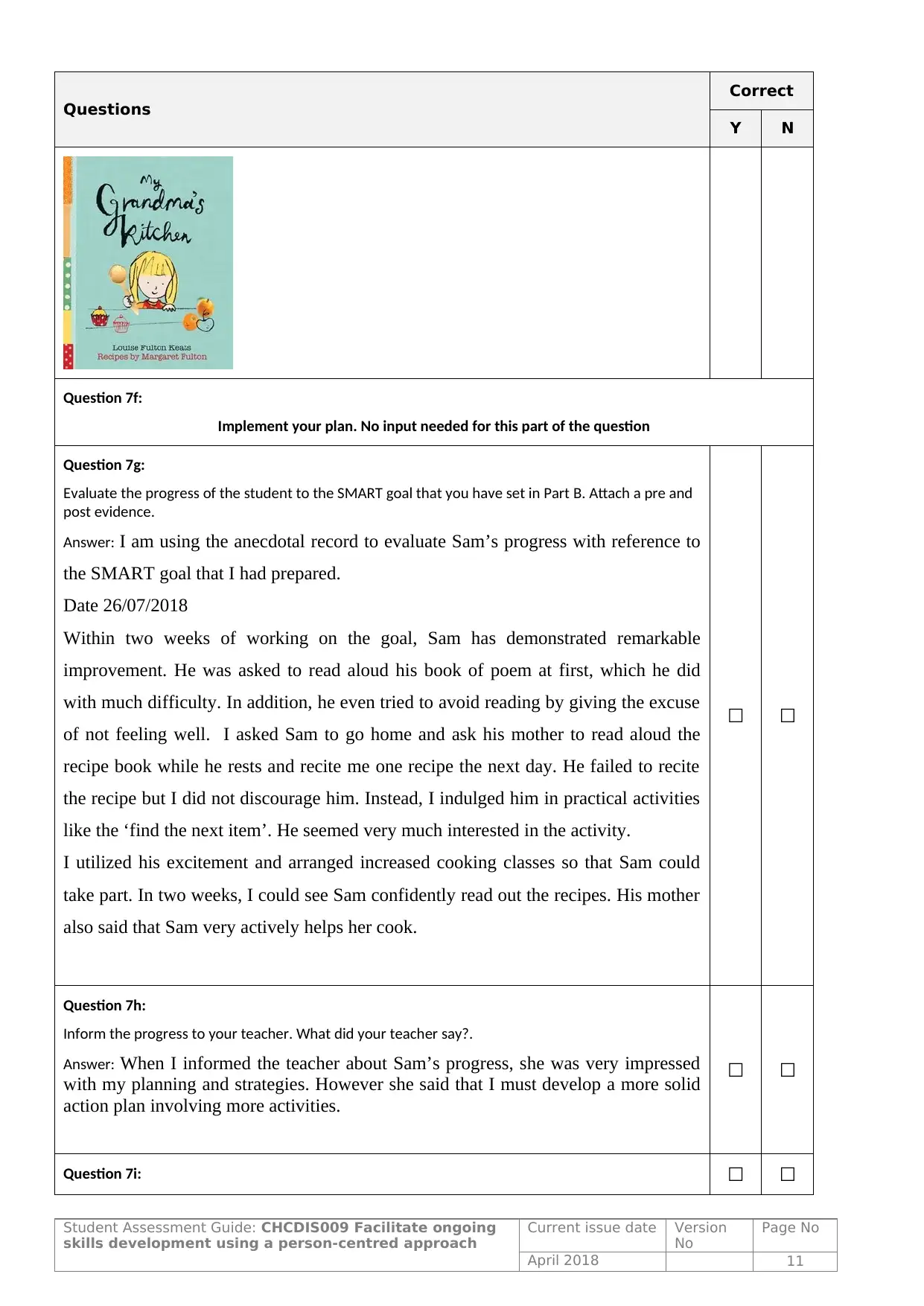
Questions
Correct
Y N
Question 7f:
Implement your plan. No input needed for this part of the question
Question 7g:
Evaluate the progress of the student to the SMART goal that you have set in Part B. Attach a pre and
post evidence.
Answer: I am using the anecdotal record to evaluate Sam’s progress with reference to
the SMART goal that I had prepared.
Date 26/07/2018
Within two weeks of working on the goal, Sam has demonstrated remarkable
improvement. He was asked to read aloud his book of poem at first, which he did
with much difficulty. In addition, he even tried to avoid reading by giving the excuse
of not feeling well. I asked Sam to go home and ask his mother to read aloud the
recipe book while he rests and recite me one recipe the next day. He failed to recite
the recipe but I did not discourage him. Instead, I indulged him in practical activities
like the ‘find the next item’. He seemed very much interested in the activity.
I utilized his excitement and arranged increased cooking classes so that Sam could
take part. In two weeks, I could see Sam confidently read out the recipes. His mother
also said that Sam very actively helps her cook.
☐ ☐
Question 7h:
Inform the progress to your teacher. What did your teacher say?.
Answer: When I informed the teacher about Sam’s progress, she was very impressed
with my planning and strategies. However she said that I must develop a more solid
action plan involving more activities.
☐ ☐
Question 7i: ☐ ☐
Student Assessment Guide: CHCDIS009 Facilitate ongoing
skills development using a person-centred approach
Current issue date Version
No
Page No
April 2018 11
Correct
Y N
Question 7f:
Implement your plan. No input needed for this part of the question
Question 7g:
Evaluate the progress of the student to the SMART goal that you have set in Part B. Attach a pre and
post evidence.
Answer: I am using the anecdotal record to evaluate Sam’s progress with reference to
the SMART goal that I had prepared.
Date 26/07/2018
Within two weeks of working on the goal, Sam has demonstrated remarkable
improvement. He was asked to read aloud his book of poem at first, which he did
with much difficulty. In addition, he even tried to avoid reading by giving the excuse
of not feeling well. I asked Sam to go home and ask his mother to read aloud the
recipe book while he rests and recite me one recipe the next day. He failed to recite
the recipe but I did not discourage him. Instead, I indulged him in practical activities
like the ‘find the next item’. He seemed very much interested in the activity.
I utilized his excitement and arranged increased cooking classes so that Sam could
take part. In two weeks, I could see Sam confidently read out the recipes. His mother
also said that Sam very actively helps her cook.
☐ ☐
Question 7h:
Inform the progress to your teacher. What did your teacher say?.
Answer: When I informed the teacher about Sam’s progress, she was very impressed
with my planning and strategies. However she said that I must develop a more solid
action plan involving more activities.
☐ ☐
Question 7i: ☐ ☐
Student Assessment Guide: CHCDIS009 Facilitate ongoing
skills development using a person-centred approach
Current issue date Version
No
Page No
April 2018 11
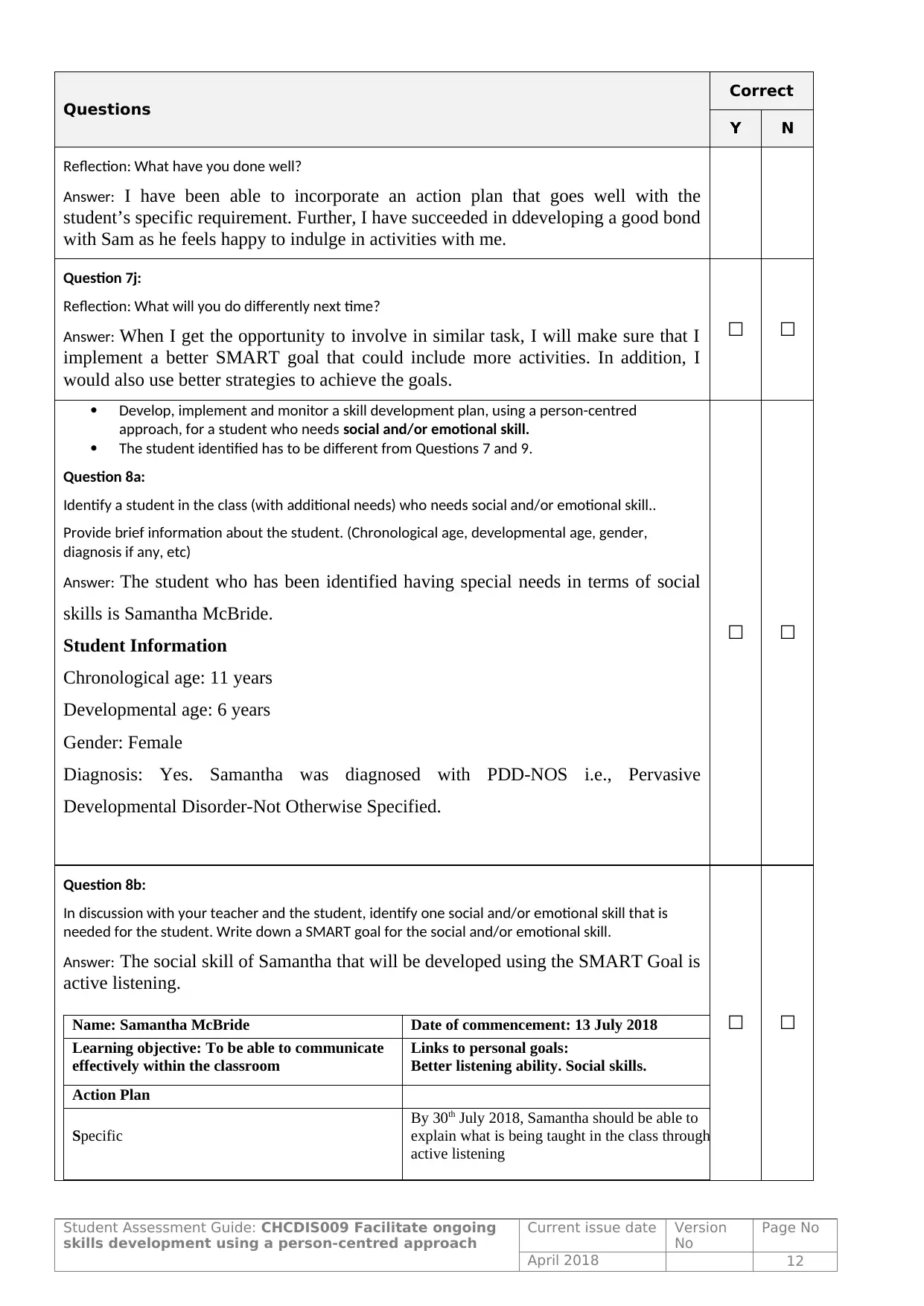
Questions
Correct
Y N
Reflection: What have you done well?
Answer: I have been able to incorporate an action plan that goes well with the
student’s specific requirement. Further, I have succeeded in ddeveloping a good bond
with Sam as he feels happy to indulge in activities with me.
Question 7j:
Reflection: What will you do differently next time?
Answer: When I get the opportunity to involve in similar task, I will make sure that I
implement a better SMART goal that could include more activities. In addition, I
would also use better strategies to achieve the goals.
☐ ☐
Develop, implement and monitor a skill development plan, using a person-centred
approach, for a student who needs social and/or emotional skill.
The student identified has to be different from Questions 7 and 9.
Question 8a:
Identify a student in the class (with additional needs) who needs social and/or emotional skill..
Provide brief information about the student. (Chronological age, developmental age, gender,
diagnosis if any, etc)
Answer: The student who has been identified having special needs in terms of social
skills is Samantha McBride.
Student Information
Chronological age: 11 years
Developmental age: 6 years
Gender: Female
Diagnosis: Yes. Samantha was diagnosed with PDD-NOS i.e., Pervasive
Developmental Disorder-Not Otherwise Specified.
☐ ☐
Question 8b:
In discussion with your teacher and the student, identify one social and/or emotional skill that is
needed for the student. Write down a SMART goal for the social and/or emotional skill.
Answer: The social skill of Samantha that will be developed using the SMART Goal is
active listening.
Name: Samantha McBride Date of commencement: 13 July 2018
Learning objective: To be able to communicate
effectively within the classroom
Links to personal goals:
Better listening ability. Social skills.
Action Plan
Specific
By 30th July 2018, Samantha should be able to
explain what is being taught in the class through
active listening
☐ ☐
Student Assessment Guide: CHCDIS009 Facilitate ongoing
skills development using a person-centred approach
Current issue date Version
No
Page No
April 2018 12
Correct
Y N
Reflection: What have you done well?
Answer: I have been able to incorporate an action plan that goes well with the
student’s specific requirement. Further, I have succeeded in ddeveloping a good bond
with Sam as he feels happy to indulge in activities with me.
Question 7j:
Reflection: What will you do differently next time?
Answer: When I get the opportunity to involve in similar task, I will make sure that I
implement a better SMART goal that could include more activities. In addition, I
would also use better strategies to achieve the goals.
☐ ☐
Develop, implement and monitor a skill development plan, using a person-centred
approach, for a student who needs social and/or emotional skill.
The student identified has to be different from Questions 7 and 9.
Question 8a:
Identify a student in the class (with additional needs) who needs social and/or emotional skill..
Provide brief information about the student. (Chronological age, developmental age, gender,
diagnosis if any, etc)
Answer: The student who has been identified having special needs in terms of social
skills is Samantha McBride.
Student Information
Chronological age: 11 years
Developmental age: 6 years
Gender: Female
Diagnosis: Yes. Samantha was diagnosed with PDD-NOS i.e., Pervasive
Developmental Disorder-Not Otherwise Specified.
☐ ☐
Question 8b:
In discussion with your teacher and the student, identify one social and/or emotional skill that is
needed for the student. Write down a SMART goal for the social and/or emotional skill.
Answer: The social skill of Samantha that will be developed using the SMART Goal is
active listening.
Name: Samantha McBride Date of commencement: 13 July 2018
Learning objective: To be able to communicate
effectively within the classroom
Links to personal goals:
Better listening ability. Social skills.
Action Plan
Specific
By 30th July 2018, Samantha should be able to
explain what is being taught in the class through
active listening
☐ ☐
Student Assessment Guide: CHCDIS009 Facilitate ongoing
skills development using a person-centred approach
Current issue date Version
No
Page No
April 2018 12
⊘ This is a preview!⊘
Do you want full access?
Subscribe today to unlock all pages.

Trusted by 1+ million students worldwide
1 out of 24
Related Documents
Your All-in-One AI-Powered Toolkit for Academic Success.
+13062052269
info@desklib.com
Available 24*7 on WhatsApp / Email
![[object Object]](/_next/static/media/star-bottom.7253800d.svg)
Unlock your academic potential
Copyright © 2020–2025 A2Z Services. All Rights Reserved. Developed and managed by ZUCOL.




